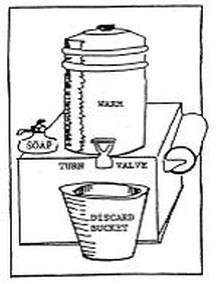Welcome to Good Market Lanka!
Click the logo to return to the Good Market app.
Welcome to Good Market Lanka! Click the logo to return to the Good Market app.
Good Market Info > Sri Lanka > Marketplace Events > Food Safety
The following mistakes can allow the growth of bacteria that cause food poisoning:
Some prepared foods are higher risk than others:

Lower Risk Foods
Medium Risk Foods
Higher Risk Foods
All food handlers should wear clean, protective clothing. Aprons are recommended. Long hair must be tied back or covered by a hat, hairnet, or similar head covering.
Use tongs or bags to avoid unnecessary handling of food.
Vendors directly handling prepared foods are responsible for bringing soap and setting up a hand washing station. All staff should be instructed in proper hand washing technique: Wet hands with clean, warm water. Apply soap. Rub hands together for 20 seconds. Clean under the nails and between fingers. Rinse under clean, running water. Dry hands.

Hands must be washed before starting work, before handling food, after handling raw food and raw food packaging, after handling money, after eating and drinking, after using the toilet, after blowing your nose, after contact with animals, after cleaning and after handling waste.
People suffering from an illness (skin, nose, throat, stomach, etc.) or infection should not be allowed to handle food for at least 48 hours after all symptoms are gone. Never cough or sneeze over food. Cuts or sores must be covered by a waterproof plaster.
Vendors should not eat or drink in areas that open food is handled. After eating, hands should be washed before restarting work.
Food must be wrapped, covered or placed in food-grade containers to prevent contamination during transport. Non-food items, raw ingredients, and ready-to-eat foods must be kept separate during transport and storage.
Clean, food-grade surfaces must be used for cutting or preparing food. Wash knives, utensils, equipment, and cutting surfaces regularly with soapy water and rinse with clean water.
Chilled food must be stored at 8°C or less. Frozen food must be stored at -18°C or less. Hot food must be stored at 63°C or more
High-risk foods must be kept cold (below 8°C) to prevent the growth of dangerous bacteria. These include meat, seafood, soft or semi-hard cheeses, yogurt and other dairy products, and cooked food that contains meat, seafood or eggs.
In many countries, the law permits a maximum of four hours out of chilled temperature control, but it is good practice to dispose of unchilled high-risk food after two hours. If a vendor cooks meat or seafood items offsite and brings them to the market, any food that remains unsold must be disposed of within 4 hours of cooking.
Vendors with high risk foods should either use a refrigeration unit or an insulated container with ice packs (e.g. frozen plastic water bottles). A thermometer is required to check the temperature on a regular basis and ensure that is remains below 8°C. High-risk vendors should keep a log book and record temperatures at least once in 2 hours.
Vendors that cook at the market should ensure that food is thoroughly cooked to 75°C or above. Vendors that are cooking meat at the market should use a food probe thermometer to confirm that a proper temperature was reached.
Prepared food and fresh eggs must not be displayed in direct sunlight because it can increase temperature and lead to bacteria growth. If a stall gets afternoon sun in the front, prepared food vendors should set up farther back. If a stall gets afternoon sun in the back, prepared food vendors should set up in the front.